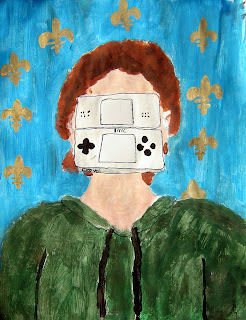You need:
- white drawing paper A4 size
- oil pastel
- blue ink
- brush
- dish with water
- scouring pad
See the moon shining through the trees... and in the moonlight everything looks blue.
Children scetch a winter tree, so there will be no leaves. Show them that the branches at the end always be thinner. Scetch a moon between the branches. Draw a cat or an owl on one of those branches.
The tree has to be coloured with blue oil pastel. Color difference can be made by pressing harder or softer, or by using a little black or white through that blue for the feathers. Colour the owl or cat blue too. Use black to draw eyes, ears and beak. The moon is white-yellow and becomes darker yellow to the outside.When colouring is ready, everything has to be outlined with white oil pastel; even the smallest branches have to be outlined. This is a difficult chore, because you barely see the white and you run the risk that the white crayon will get blue (scrape it then!).
The background will be painted with ink, water and a scouring pad (watch your clothes!). The white lines will resist the ink. Put undiluted blue ink on a dish and dip the soft side of the scouring pad in it. Stamp with the pad along the outer edges of the drawing. Add water to the ink when you're nearer at the moon. The blue will be lighter then. Make a great light blue circle around the moon.















































